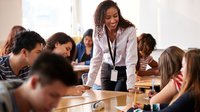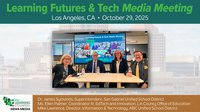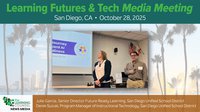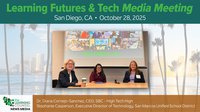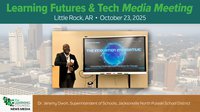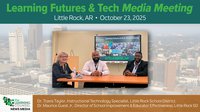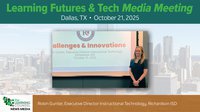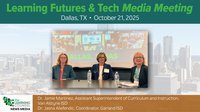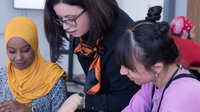What’s to become of learning from what we have learned during the COVID-19 crisis?
It’s a struggle for anyone who sees patterns to communicate them adequately. One always sounds like they are spouting gibberish and insanely trying to predict the future. Actually, predicting the future always relies on some basic things that never change and typically uses an overarching pattern called a lifecycle. What’s a lifecycle? It’s what humans have from birth through maturity and then a downward curve to death. It’s a curve like the bell curve that educators know very well. Both predict a similar concept of an arced continuum. Whole civilizations have this as well as all their minor parts including cities and institutions coming and going, rising and falling. Investors will tell you that the trick is to know when something is going up and when it is going down and bet accordingly.
What isn’t commonly considered is that after something goes down, or even during its slow demise, what new things are taking its place and at what speed of change? In considering the education field, this perspective has consumed my thoughts for years. With my first book, “The Consumerization of Learning,” I even wrote fiction in the last chapters illustrating days in the lives of future students and teachers.
Lifecycle Pattern

What is the future because of the past for education? History has trend cycles and understanding them can help with understanding the inevitable direction things will go and how fast. There are plenty of before and after stories in history. The reason we study history is to not repeat the failures of the past, and to recognize when things are turning so leaders can chart the right course forward.
It’s important for leaders to be “in the moment” helping their organizations manage daily demands, but even more important to make decisions while keeping in mind the direction of trends. In the 1800s the cycle has gone from people being educated by their parents or tutors and local churches, to local families grouping together to pay for teachers and the “one-room schoolhouse,” to churches taking on larger burdens, and then society deciding to make education universal. Then came the industrial revolution and schools were reorganized with population growth to be multiple classrooms and grade-structured. This was similar to a manufacturing line with batches of goods moving through and timed for breaks with ringing bells. The structure fit the age and what was needed by graduates in the work world. Eventually this built up into multiple layers above schools with districts, service centers and local education authorities for multiple districts, and state and federal agencies. The layers all required reports and meetings while trying to help. This mirrored the bureaucracies of large manufacturing plants and the rest of government with central planning authorities. The entire direction was towards aggregation and centralization.

Around the year 2000, education reached a turning point where not just some of the learner consumers and their parents were jumping ship, a lot of teachers and administrators were also tired out and beginning to retire in mass numbers. The massive and monolithic structured bureaucracy reached a pinnacle of red-tape obstructionism and great weight in policies and programs. It’s at this point that an increasing disaggregation and decentralization started, along with the school choice movement and more. This is a natural cycle. It follows the Roman Empire cycle which grew to a weighty enforced taxation and bureaucracy, decay and then everyone for themselves with no central authority responsible for hundreds of years of barbarism. In our present culture, clearly technology is pushing a faster decay of the old way of schooling. After all, the Internet has dramatically changed nearly every other industry and it’s easy to see that education is changing now that mankind’s accumulation of knowledge is on-demand and nearly instantaneous.
The turning point also coincided with the massive incursion of computing devices on campus and in administration. Innovations in software learning instigated a massive growth in homeschooling as well as charter schools which could more easily be administered with advanced organizational software cutting the costs of staffing. Online learning then started to become a real alternative, especially with vast improvements in user interface and user experience. No longer were students getting “lost” in navigation of systems, or very rarely. Achievement assisted by digital and Internet access became the norm in studies.
These things all fueled a dramatic shift in support for the school choice movement. This in turn fueled a mood for school reform by administrators in order to appear competitive, including implementing blended learning and various definitions of personalized learning, although not personalized the way consumers would typically define it as a pathway just for that one student.
Meanwhile companies like Mathnasium started opening a dizzying number of stores selling exclusively math achievement, proving that what consumers want is guaranteed personalization. Other private industry innovations continued to emerge, stacking up more expectations by parents and students on schools.
When the Learning Counsel started its research journey in 2013, the rate of change inside education was marked at 4-1 or being driven at a rate of fitting four years of modification into one. This meant rapid-fire new programs, massive rollouts, a turn-over of leadership constantly, and more. The change rate in education is now marked at 10-years-to-1 because the pressure of opt-out to alternatives and failures in achievement is so high that schools can plan for a new school year and find they have less than fifty percent of the students they were expecting on opening day. Having to do a complete pivot in a short amount of time causes immediate layoffs and school consolidations.
Going back to the Fall of Rome analogy, what must be avoided is a decay into a sort of educational barbarism with vast inequities and still declining results. Yet the direction indicated by cultural trends looks impossible to turn around. The disaggregation starting around the year 2000 was partly driven by a consumerization of digital learning resources which has now reached a rate of spend by consumers that is 2-1 overall spend by schools, public or private. America has woken up to the fact that they can access a vast amount of knowledge directly without the intermediation of any institutions. This is increasing homeschoolers, who are not just opting out because of lack of achievement in public schools, but for quality of life.
Opting in to a better life
The opting-out for flexibility, family time and overall better life experience is causing schools to offer segmented services like “one course a day” on campus with all else done remotely and mobile, rolling drop-off times, state-required testing for homeschoolers, and a large variety of remedial and extra-curricular programs. Some schools also offer lab environments as shared resources for other local schools just like universities, and office hours for teachers or curriculum leaders for visits or call-in by remote students mostly studying from home. An overlay of services is available from companies for things like special needs speech pathology lessons out-sources some services in shared infrastructure nationally. These are the same sorts of things that have happened in private industry. In the last thirty years, millions of jobs have been outsourced overseas to India, China, the Ukraine and other nations. The same sort of cost constrictions have come home to education, including rural hiring of teachers-on-demand or telecommuting to fill needs when hiring locally is not feasible.
The observable new growth cycle because of technology and choice is an inverse of the past, particularly now that the entire U.S. has experienced forced shut-down of schools. The past worked to aggregate all control of learning into public traditional schools with a specific structure that required constant physical presence and offered a manufacturing model of classes and grades. The new cycle is disaggregating that, decentralizing it so that learning can be from anywhere with human teaching inserted at junctures as needed, leveraging technology to bring more personalization for each learner. That is how uber works. It connects the nearest driver with the rider who needs transport. It uses a central app to run these algorithms and a distributed model rather than central dispatch and a few taxi-stand hubs. It follows, given some of the clues, that disaggregation will continue until a new aggregation and centralization cycle takes place. In fact, the new form of aggregation is already forming and in the same way as other industries have formed – think uberization and personalized learning workflow as the probable distributed model. Huge volumes of content and courseware exists but have yet to form into a complete mindfulness and workflow that still integrates a physical school “place.” That tech “mind” as a centralization like the Uber app, Amazon, or Fed-X logistics, has yet to fully materialize. What’s important to see is that all those commercial apps cause transactions that intersect with the real world but from a centralized machine mindfulness and direct interaction with users online. The art of using human teaching to intersect as needed will also do two things: 1) ameliorate the huge lack of teachers to fill roles in the old structure because the structure shifts to needing other roles, outsourcing or sharing, or doubling-up teacher instructional duty because other duties are laid off on house leaders and curriculum services staff, 2) inspires new life in the profession through flexible hours and plenty of new roles for existing faculty.
Personalized Workflow Learning

Schools are now discussing a new type of learning first discussed by the Learning Counsel called “Personalized Workflow Learning” that provides a greater focus on experience through a blending that is not done just in the classroom but institution-wide through technology systems. The goal is to bring a seamless quality experience, heavy on human interaction when in school. This moves “blended learning” up from a classroom-level conversation all the way to “blended institution” which draws and delivers online while orchestrating memorable experiential learning. Once all curriculum is mapped end-to-end with digital and live instruction, then personalized workflow learning, also known as the uberization of education can occur so that every student gets a personalized path but still has live interaction. At this stage will be simple algorithms to determine better automated workflow like decision tree logic. This will naturally lead to the business of professional digital learning travel guides who help with the selection of digital curriculum, old-fashioned paper curriculum, needed lectures, projects and more for normal subjects as well as totally custom curated paths for new subjects or special interests. This will then lead to even more service segmentation, various schools and districts vying for reputation as they provide different angles on K12 similar to higher education. While this is going on, more and more augmented intelligence will bring more structure and meaningful help to make teaching and learning more efficient.
The full redefined education arena will be service oriented, student centric and full of options. While students will always have a need of the basic subjects schools already deliver today, augmented intelligence may in the future surface inquiry trends that can be met by schools on-the-fly in the same way that Internet advertising surfaces suggestions to you as you shop.
The concerns for education leaders should be charting a path to shift their delivery structure one small step or part, such as one subject or one part of the daily schedule changed. For all educators, the concern for the future should be about what human skills will be needed the most. The refinement of all teacher’s direct instruction know-how is predicted to be biggest leadership challenge of the next several decades.
About the author

LeiLani Cauthen is the CEO and Publisher of The Learning Counsel. She is well versed in the digital content universe, software development, the adoption process, school coverage models, and helping define this century’s real change to teaching and learning. She is an author and media personality with twenty years of research, news media publishing and market leadership in the high tech, education and government industries.


